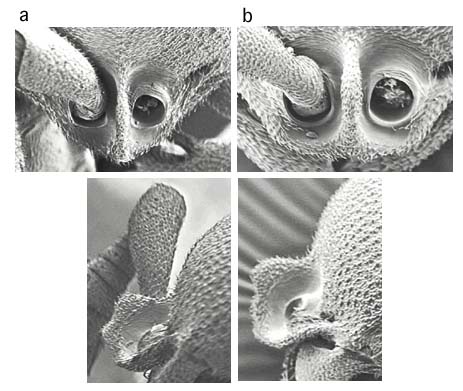
| Genus List | Species List | Genus Overview |
10a. Interantennal lamella forming an obtuse angle between antennal insertions and descending to a somewhat projecting clypeal shelf, so that lamella appears rectangular in lateral view; antenna 8-9 segmented: 50
10b. Interantennal lamella projecting as an acute angle between antennal insertions, descending to relatively shorter clypeal shelf, so that lamella appears triangular in lateral view; antenna 6-9 segmented: 100

50a. Anterior clypeal margin subtriangular; interantennal lamella with small tooth; face shagreened; color orange: denticulata
50b. Anterior clypeal margin shallowly convex to flattened; interantennal lamella usually lacking tooth; face relatively more foveate; color usually dark red brown: 75

75a. Size relatively small, HW about 0.4mm: horni
75b. Size relatively larger, HW greater then 0.45mm: JTL-009
100a. Abdominal segment 4 elongate, in lateral profile parabolic and somewhat pointed posteriorly; antenna 9-segmented; body covered with suberect pubescence, and with short erect hairs on tibiae; anterior clypeal apron short, flat to slightly concave, with short projecting hairs: JTL-006
100b. Abdominal segment 4 hemispherical; antenna 6-9 segmented; pubescence on body short, fully appressed, no erect hairs on tibiae; anterior clypeal apron variable, lacking projecting hairs: 200

200a. Face densely punctulate, mat; interantennal lamella relatively larger, with ventral margin originating at anterior border of clypeus, such that in side view ventral portion of lamella is usually visible; clypeus projecting relatively farther beyond mandibles; antennae 6-9 segmented: 300
200b. Face sublucid; interantennal lamella relatively smaller, a tooth originating between antennal insertions, well above anterior margin of clypeus, such that in side view lamella is usually not visible, obscured by antennal scapes; clypeus projecting relatively less beyond mandibles; antennae 7-segmented: humilis

300a. Antennae 6 segmented: sexarticulata
300b. Antennae 8-9 segmented: JTL-005

Page author:
John T. Longino, The Evergreen State College, Olympia WA 98505 USA.longinoj@evergreen.edu